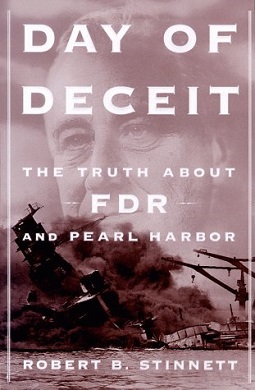Day of Deceit facts for kids

First edition
|
|
| Author | Robert Stinnett |
|---|---|
| Subject | Pearl Harbor advance-knowledge conspiracy theory |
| Publisher | Free Press, Edition: Touchstone ed |
|
Publication date
|
1999 |
| Pages | 416 |
| ISBN | 0-7432-0129-9 |
| 940.5426 | |
| LC Class | D767.92.S837 |
Day of Deceit: The Truth About FDR and Pearl Harbor is a book written by Robert Stinnett. It was published in 1999. The book makes a big claim about the attack on Pearl Harbor. It suggests that Franklin D. Roosevelt, who was the US President, and his government knew about the attack beforehand.
The book argues that they might have even allowed the attack to happen. The goal, according to Stinnett, was to bring the United States into World War II. The book says that the Japanese fleet was found using radio messages. But this important information was supposedly kept secret from Admiral Husband E. Kimmel. He was the commander of the United States Pacific Fleet at that time.
What the Book Claims
Stinnett's book starts with a special document. It's called the McCollum memo. Lieutenant Commander Arthur H. McCollum wrote this memo in October 1940. Stinnett got a copy of it using the Freedom of Information Act. This law lets people ask for government documents.
McCollum worked for the Office of Naval Intelligence. He wrote about the situation in the Pacific Ocean. He listed eight actions the US could take against Japan. Stinnett calls these actions "provocations." He believes they were meant to make Japan angry.
One of McCollum's suggestions was to "Keep the main strength of the U.S. fleet now in the Pacific in the vicinity of the Hawaiian Islands." Stinnett thinks this was a plan. He believes it was meant to trick the Japanese into attacking the US fleet. The book claims the overall goal was to start a war. This would allow President Roosevelt to join the fight against Germany. This would help the United Kingdom.
The book also says that commanders like Walter Short and Admiral Kimmel were told to stay on defense. Stinnett claims that important spy information was kept from them. This would stop them from preparing a good defense. He also states that radio messages from the Japanese fleet were heard. These messages would have shown where the fleet was going. But this information was also supposedly hidden. This would leave the US forces unprepared. Stinnett believes all these actions came from the White House. He says President Roosevelt knew about them and wanted them to happen.
Why Historians Disagree
Many historians who study this time period do not agree with Stinnett's ideas. They have found some mistakes in his book. They also point out that some of the sources he used might not be reliable. However, the book is often mentioned by people who believe in "advance knowledge theories." These theories suggest that the US knew about the Pearl Harbor attack before it happened.

